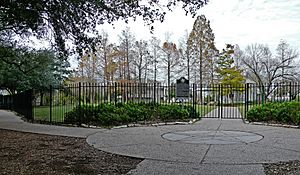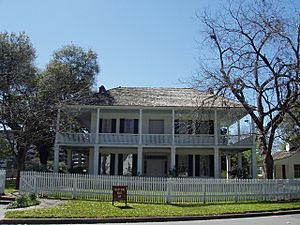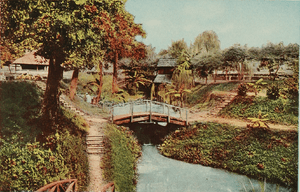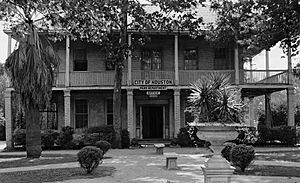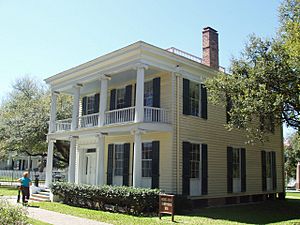Sam Houston Park facts for kids
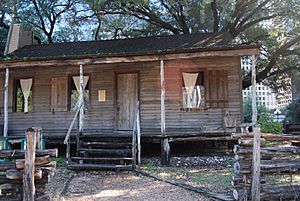
Sam Houston Park is a special green space in downtown Houston, Texas, United States. It's like a living museum, showing off old buildings and the culture of Houston's past. This park was the very first one created in the city. It was started on land bought by former Mayor Sam Brashear in 1900.
Contents
- Discovering Sam Houston Park's History
- The Heritage Society: Protecting History
- Exploring Historic Buildings in the Park
- The Oldest Structure: The Old Place
- Houston's Oldest Brick Home: Kellum-Noble House
- The Nichols-Rice-Cherry House Story
- Fourth Ward Cottage: A Unique Home
- San Felipe Cottage: German Architecture
- The Pillot House: A Trendsetter
- Yates House: A Minister's Home
- St. John's Church: A Community Gathering Place
- Baker Family Playhouse: A Child's Delight
- Staiti House: Modern Conveniences
- Park Monuments
- Images for kids
- See also
Discovering Sam Houston Park's History
In 1899, Mayor Samuel H. Brashear chose Houston's first park committee. Their job was to create a city park. The chosen land, about 20 acres, was turned into a beautiful Victorian-style village. It had walking paths, an old mill, and a bridge over a small stream. The park even included a 52-year-old house that had been used as a school.
The original park plan, designed by City Engineer John Maxey, included the Kellum-Noble House. There was also a drive with a bridge over Buffalo Bayou. Other cool additions were a bandstand, a pavilion, and a conservatory. A pond and an arbor made the park even more scenic.
The Heritage Society: Protecting History
The Heritage Society was started in 1954 by Houstonians Faith Bybee, Harvin Moore, and Marie Phelps. Sam Houston Park has been its home ever since.
This group works to save the history of Houston and Harris County. They do this by fixing up old buildings and showing historical items. They also teach people about the area's past and how it connects to today and the future.
You can also find a small Heritage Society Museum in Sam Houston Park. It's at the corner of Bagby and Lamar Streets and is dedicated to keeping Houston's history alive.
Exploring Historic Buildings in the Park
Sam Houston Park is home to many historic houses. These buildings show what life was like in different time periods. You can see everything from a cabin built before the Texas Revolution to an 1891 church. This church was built by German and Swiss immigrants. One of the most famous is the Kellum-Noble House, which is Houston's oldest brick home, built in 1847. You can take guided tours of these restored buildings with the Heritage Society.
The Oldest Structure: The Old Place
The Old Place is a log cabin that was likely built around 1823. It's thought to be the oldest building still standing in Harris County. It was moved to the park in 1973 from its first spot by Clear Creek. In 2003, it was moved again to higher ground. This was because floods, like during Tropical Storm Allison in 2001, had reached its roof.
Houston's Oldest Brick Home: Kellum-Noble House
While the Old Place is the oldest cabin, the Kellum-Noble House is the oldest building originally from Houston. Nathaniel Kellum built this house in 1847 next to his brickyard. He sold it in 1850. The next year, Zerviah Noble bought it and used it as a primary school until 1899.
The house has two main rooms separated by an open breezeway. A double porch wraps around the entire house. The City of Houston bought the house in 1899 as part of the park land. The Heritage Society saved it in 1954 and had it renovated. It opened as a county museum four years later. The Kellum-Noble House reopened in 2019 after more work.
The Nichols-Rice-Cherry House Story
The Nichols-Rice-Cherry House was built around 1850. It was first located across from the Harris County Courthouse. A Houston merchant named Ebeneezer Nichols built it. Later, William Marsh Rice, a very important businessman, owned it. The house moved several times. An artist named Emma Richardson Cherry bought it, fixed it up, and moved it to the Montrose area.
The Heritage Society later moved this Greek Revival style house to Sam Houston Park. They restored it to look like it did when Rice owned it. They also created a room to show what Cherry's art studio might have looked like.
Fourth Ward Cottage: A Unique Home
The Fourth Ward Cottage was originally a home for a German family in the mid-1800s. It was located in the Fourth Ward, a neighborhood that became known as Freedman's Town after the Civil War. African Americans moved into this area. The house today is a mix of styles. It combines an Arcadian cottage in the front with a two-room cottage in the back. This makes it look like the "shotgun houses" common in that old neighborhood. The Heritage Society moved it to the park in 2002.
San Felipe Cottage: German Architecture
The San Felipe Cottage was built in 1868. Its original spot was on what is now West Dallas Street. This house is a great example of the common building style used by German settlers. It was moved to Sam Houston Park in 1962.
The Pillot House: A Trendsetter
The Pillot House is named after Eugene Pillot, a Houston businessman. His family came to Texas in 1837 and ran a lumber business. They also built the Pillot Building in 1858. Eugene and Zeolide Pillot built this house in 1868 and raised six children there. The Pillot family donated the house to the Heritage Society in 1965.
This house was very modern for its time. It had an attached kitchen, gas lighting, and closets. It also had features to help keep cool during hot Texas summers. Two cast iron dogs stand in front of the home.
Yates House: A Minister's Home
The Yates House is another home in Sam Houston Park that came from Freedmen's Town. John Henry Yates, a former enslaved person, built this house in 1870. He became a minister and teacher in Houston. The house has a simple double porch on the front, typical of the Greek Revival style. Yates's family donated the house, and the Heritage Society moved it to the park in 1994.
St. John's Church: A Community Gathering Place
St. John Church was originally built in northwest Harris County in 1891. It was moved to Sam Houston Park in 1968. This church served German Lutherans. Its style was common for churches in the American South. It has a rectangular shape, a pointed roof, and a bell tower.
Baker Family Playhouse: A Child's Delight
The Baker Family Playhouse is located behind the Nichols-Rice-Cherry House in Sam Houston Park. James A. Baker built this playhouse for his daughter Alice around 1893.
Staiti House: Modern Conveniences
The Staiti House was built in 1905 by Henry Staiti as an investment. It was originally in the Westmoreland Place neighborhood. It was updated and renovated in 1915. This house was known for its modern features, like electric lights and a built-in refrigerator. The Heritage Society moved it to Sam Houston Park in 1986.
Park Monuments
- World War I Monument
- Confederate monument: This monument was moved from its original spot.
Images for kids
See also
- Scanlan Fountain


